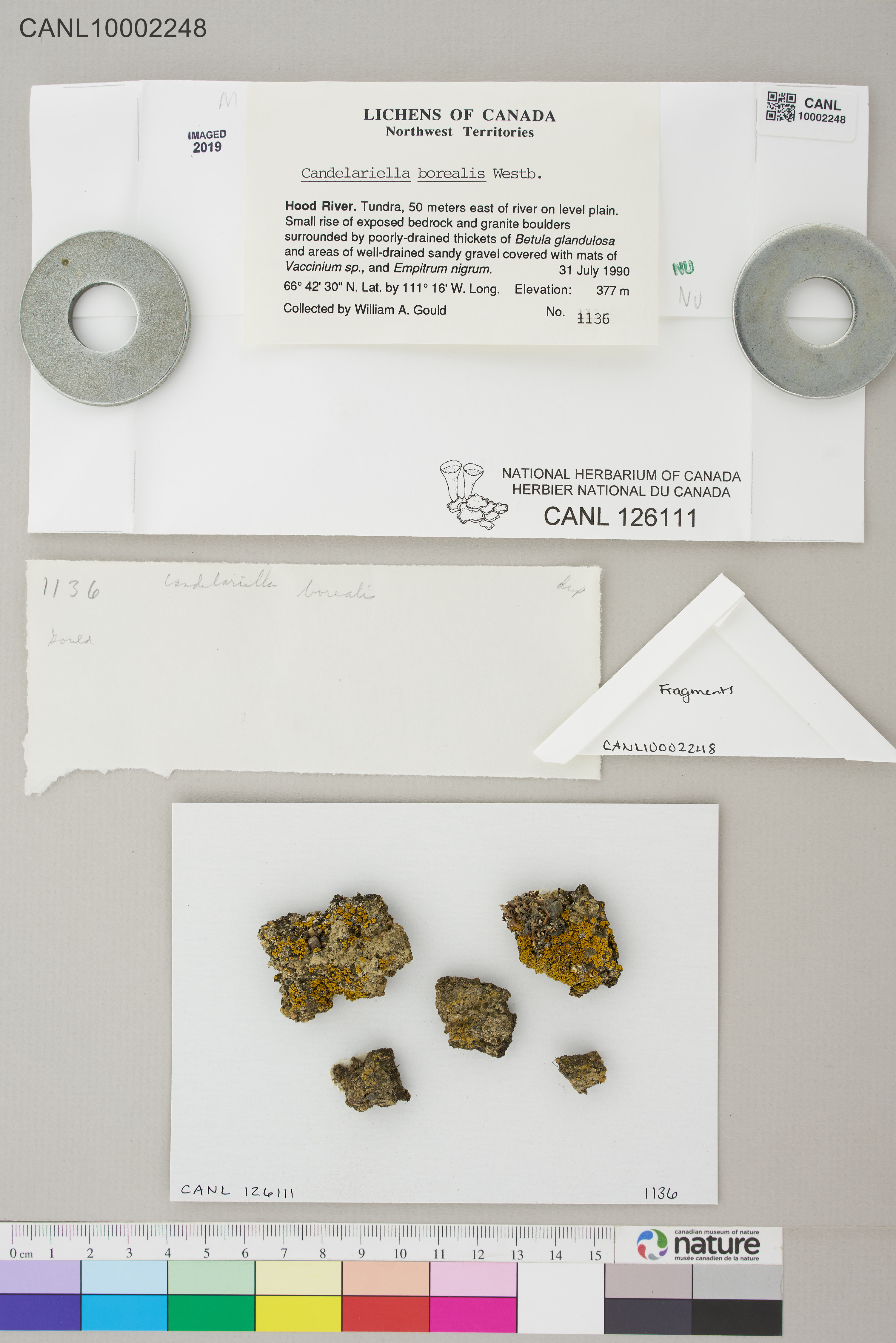
- Home
- Search
- Images
- Species Checklists
- US States: O-Z >
- US National Parks
- Central America
- South America
- US National Parks
- Southern Subpolar Region
|
|
|
|
Family: Candelariaceae
|
Description.Thallus squamulose; squamules scattered to crowded, adnate or more often prostrate to ascending, irregular in shape, incised to lobate, often with somewhat swollen tips, to 1.5 mm long; surface yellow to orange yellow, smooth, matte; thallus anatomy: pseudocortex indistinct, 5–15 µm thick, of non-gelatinized hyphae with 6 isodiametric cells, 4–8 µm wide; algae chlorococcoid, max. diam. ca. 15 µm, scattered throughout the thallus but more concentrated towards the upper surface; lower cortex similar to the upper cortex. Apothecia rare (not seen in material from the U.S.A.), lecanorine, rounded to deformed, 0.45–1.1(–1.8) mm; disc flat, concolorous with or darker yellow than the thallus; thalline margin persistent or occasionally partly excluded, variable in thickness, to 0.3 mm wide, even to flexuose; proper margin usually indistinct from the outside, occasionally visible as a smooth ring between the disc and the thalline margin; apothecial anatomy: thalline margin with an indistinct pseudocortex similar to the thallus cortex, 10–20 µm thick, proper margin usually indistinct, but sometimes to 30 µm thick in the uppermost part, of radiating hyphae with 6 rectangular cells 5–9 X 1–2 µm, in the uppermost part becoming somewhat shorter and rounded; subhymenial layers colorless, with oil droplets; epihymenium reddish yellow to yellow-brown; hymenium colorless, 80–110 µm tall; paraphyses simple or branched near the tips, 1.5–2.0 µm in midhymenium, tips cylindrical to clavate, to 3.5 µm wide; asci clavate, mostly ca. 30-spored, 77–86 X 21–24 µm; ascospores colorless, simple or sometimes with a thin septum, +/- ovoid to oblong, (8–)8.5–11.5(–12.5) X (4-)4.5–6.0(–7.0) µm (N=46). Pycnidia rare, immersed in the thallus, appearing as orange yellow spots; conidia +/- narrowly ellipsoid, 2.5–3.0 X 1.0–1.5 µm. Chemistry.Calycin (45%), pulvic acid lactone (17%), vulpinic acid (21%) and pulvinic acid (17%) found by HPLC; spot tests: K+ orange, KC-, C-. Ecology.Candelariella borealisis a terricolous species growing among bryophytes and cyanobacteria. It also occurs as a pioneer species on bare sand or mineral soil, often in rather moist situations. It appears to be a fairly common species in the Arctic tundra and in the alpine, tundra habitats of the Rocky Mountains, from ca. 3000 m and higher. Distribution.This species shows a circumpolar-Arctic distribution extending into the alpine regions of North America (Fig. 2). Compared to the closely related species C. placodizans, it has a more pronounced Arctic distribution and appears to become the more common of the two at higher latitudes. In Scandinavia, e.g., it is only found at high altitudes in the northernmost parts, whereas C. placodizansreaches the southern parts of the Norwegian mountains. Notes. Material of Candelariella borealiswas earlier included in C. placodizans. Compared to this species, C. borealis is larger and has a darker yellow thallus with a smooth surface. The differences are distinct and easily observed when the two species are growing together. Anatomically there is little difference except for tips of the paraphyses, which in C.placodizansare somewhat broader and sometimes capitate. |












